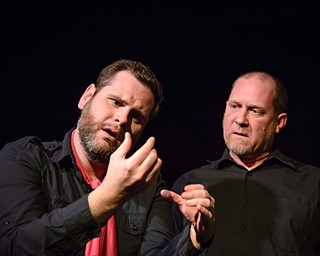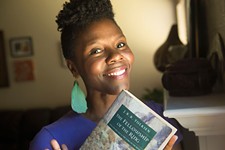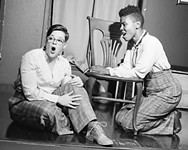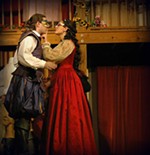Reframed
Photography provides the impetus for improv in this new project from LuckyChaos Theater
Reviewed by Stacy Alexander Evans, Fri., Jan. 10, 2014
Salvage Vanguard Theater, 2803 E. Manor Rd., 512/474-7886
www.luckychaos.com
Through Jan. 11
Running time: 1 hr., 20 min.
Ceej Allen is a celebrated figure on the Austin improv scene. A member of the award-winning Mamet-esque troupe Confidence Men and a regular contender in the Hideout's weekly Maestro series, Allen is well-positioned to draw crowds for Reframed, his new collaboration with LuckyChaos Theater Projects.
As conceived by co-producer Leng Wong, the Reframed experience is both static and dynamic, featuring an exhibit showcasing photography by Steve Rogers in the SVT lobby as well as a 90-minute joyride through some of the most difficult terrain for improvisers, employing a device known as the "Harold."
If Rush and Tool typify "musician's rock," the Harold is "improviser's comedy": ambitious, technically challenging, and hugely satisfying when done well. Do Allen and his team (Craig Kotfas, Bryan "Lubu" Roberts, Meredith Mae Roberts, Scott Hearne, Heidi Rogers, Luke Wallens, and Christina Parrish, with Content Love Knowles providing a fitting musical counterpoint on the electric piano) pull it off? Prog rock reference aside, improv's appeal is more Sub Pop than sublime: The beauty lies in its flaws. Out of its tiny failures spring brilliant recoveries, and we cheer loudly in these moments because they're so typical of the gorgeous catastrophe of life on Earth. The night I saw was a good one for this ensemble, rich with platinum and fool's gold – and, on the whole, enjoyable.
Compared to the manic environment of theatresports-style improv, Reframed is more of an intellectual exercise, yet the absurdity of it – this is comedy, after all – keeps it far from dry. The group deftly weaves recurring themes across scenes and among trios of performers, who take their cues from photographs displayed on a large screen behind them.
During the first act, the effect is not unlike bearing witness to a creative writing class asked to glean inspiration from photojournalism. Only instead of having to write about, say, Nepalese activists burning an effigy of their prime minister, performers become animate after viewing images of domestic scenes or previous creative performances. In the second act, the plot thickens as the improvisers use images of their own performances taken during act one as a springboard for further interpretation.
Interestingly enough, although subject matter related to everything from typography to social networking appears again and again, in the end one dominant motif emerges: the birth story. Two therapists enter a portal in their office and end up in a womb. Before long, an entire youth kickball team arrives there, along with a professor who was recently denied tenure and refuses to come out.
It doesn't take a rocket scientist to see the metaphor here: the birth story as a symbol of the birth of story – an event that aptly defines the craft of improvisational theatre. Talk about coming full circle. Del Close would be proud.













